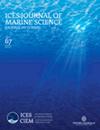阿拉伯青鱼、太平洋沙矛和尖头鲽的宽带目标强度
IF 3.4
2区 农林科学
Q1 FISHERIES
引用次数: 0
摘要
目标强度(TS)测量对于利用渔业声学估算物种丰度非常重要。然而,大多数研究人员仅使用有限的几个代表性频率对无鳔鱼类(无鳔鱼类)进行声学测量。在这里,我们使用两台宽带回声测深仪测量了三种无鳔鱼类的宽带 TS,它们是阿拉伯青鱼(Pleurogrammus azonus)、太平洋沙矛(Ammodytes personatus)和点头鲽(Cleisthenes pinetorum)。使用系绳法在海水水箱中对 45-90 千赫和 80-120 千赫频率范围内的 TS 进行了测量。在高频率下,点头鲽和阿拉伯青鱼的 TS 和指向性均高于低频。然而,太平洋沙矛的 TS 在测量的频率频谱上相对平坦。此外,尖头鲽和太平洋沙鲽的 TS 可表示为体长的函数,而阿拉伯青鱼的 TS 则可表示为体长和频率的函数,这可用于鱼类物种鉴别和大小估计。本文章由计算机程序翻译,如有差异,请以英文原文为准。
Broadband target strength of arabesque greenling, Pacific sand lance, and pointhead flounder
Measurement of target strength (TS) is important for estimating the abundance of species using fisheries acoustics. However, most researchers have only used a limited number of representative frequencies for acoustic measurements of fish without a swim bladder (bladderless fish). Here, we measured the broadband TS of three bladderless fish species, arabesque greenling (Pleurogrammus azonus), Pacific sand lance (Ammodytes personatus), and pointhead flounder (Cleisthenes pinetorum), using two broadband echosounders. TS measurements were conducted in a seawater tank over frequency ranges of 45–90 and 80–120 kHz using a tether method. Higher TS and directivity were observed at higher frequencies than at lower frequencies for pointhead flounder and arabesque greenling. However, the TS for Pacific sand lance was relatively flat over the measured frequency spectra. Additionally, the TS of pointhead flounder and Pacific sand lance could be expressed as a function of body length and the TS of arabesque greenling could be expressed as a function of body length and frequency, which could be used in fish species discriminations and size estimations.
求助全文
通过发布文献求助,成功后即可免费获取论文全文。
去求助
来源期刊

ICES Journal of Marine Science
农林科学-海洋学
CiteScore
6.60
自引率
12.10%
发文量
207
审稿时长
6-16 weeks
期刊介绍:
The ICES Journal of Marine Science publishes original articles, opinion essays (“Food for Thought”), visions for the future (“Quo Vadimus”), and critical reviews that contribute to our scientific understanding of marine systems and the impact of human activities on them. The Journal also serves as a foundation for scientific advice across the broad spectrum of management and conservation issues related to the marine environment. Oceanography (e.g. productivity-determining processes), marine habitats, living resources, and related topics constitute the key elements of papers considered for publication. This includes economic, social, and public administration studies to the extent that they are directly related to management of the seas and are of general interest to marine scientists. Integrated studies that bridge gaps between traditional disciplines are particularly welcome.
 求助内容:
求助内容: 应助结果提醒方式:
应助结果提醒方式:


